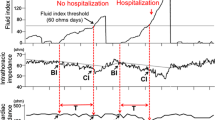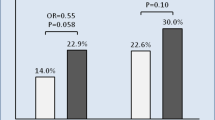Abstract
Purpose
To determine the association between device-determined diagnostic indices, including intrathoracic impedance, and heart failure (HF) hospitalization.
Methods
Clinical and device diagnostic data of 558 HF patients indicated for CRT-D therapy (In Sync Sentry, Medtronic Inc.) were prospectively collected from 34 centers. Device-recorded intrathoracic impedance fluid index threshold crossing event (TCE), mean activity counts, tachyarrhythmia events, night heart rate (NHR) and heart rate variability (HRV) were compared within patients with vs. without documented HF hospitalization.
Results
Mean follow-up was 326 ± 216 days. Patients hospitalized for HF had significantly higher rates of TCE, a higher percentage of days with the thoracic impedance fluid index above the programmed threshold, a higher percentage of days with low activity, with low HRV or with high NHR.
Multivariate analysis showed that TCE resulted in a 36% increased probability of HF hospitalization. Both TCE duration and patient activity were also significantly associated with hospitalization. Kaplan Meier analysis indicated that patients with more TCE events were significantly more likely to be hospitalized (log rank test, p = 0.005).
Conclusions
Decreased intrathoracic impedance, low patient activity and low HRV were all independently associated with increased risk for HF hospitalization in HF patients treated with resynchronization therapy. Device-derived diagnostic data may provide valuable and reliable indices for the prognostic stratification of HF patients.



Similar content being viewed by others
References
Adamson, P. B., Smith, A. L., Abraham, W. T., Kleckner, K. J., Stadler, R. W., Shih, A., et al. (2004). Continuous autonomic assessment in patients with symptomatic heart failure: prognostic value of heart rate variability measured by an implanted cardiac resynchronization device. Circulation, 110(16), 2389–2394.
Vollmann, D., Nagele, H., Schauerte, P., Wiegand, U., Butter, C., Zanotto, G., et al. (2007). Clinical utility of intrathoracic impedance monitoring to alert patients with an implanted device of deteriorating chronic heart failure. European Heart Journal, 28(15), 1835–1840.
Andriulli, J., Coles, J., & Hettrick, D. A. (2008). Association between decreased intra-thoracic impedance and ventricular tachyarrhythmias. International Journal of Cardiology, 123(3), 333–334.
Yu, C. M., Wang, L., Chau, E., Chan, R. H., Kong, S. L., Tang, M. O., et al. (2005). Intrathoracic impedance monitoring in patients with heart failure: correlation with fluid status and feasibility of early warning preceding hospitalization. Circulation, 112(6), 841–848.
Matsushita, K., Ishikawa, T., Sumita, S., Kobayashi, T., Ogawa, H., Inoue, N., et al. (2006). Daily shock impedance measured by implantable cardioverter defibrillator is useful in the management of congestive heart failure. Circulation Journal, 70(11), 1462–1465.
Maines, M., Catanzariti, D., Cemin, C., Vaccarini, C., & Vergara, G. (2007). Usefulness of intrathoracic fluids accumulation monitoring with an implantable biventricular defibrillator in reducing hospitalizations in patients with heart failure: A case-control study. Journal of Interventional Cardiac Electrophysiology, 19(3), 201–207.
Luthje, L., Vollmann, D., Drescher, T., Schott, P., Zenker, D., Hasenfubeta, G., et al. (2007). Intrathoracic impedance monitoring to detect chronic heart failure deterioration: Relationship to changes in NT-proBNP. European Journal of Heart Failure, 9(6–7), 716–722.
Heist, E. K., & Ruskin, J. N. (2006). Atrial fibrillation and congestive heart failure: risk factors, mechanisms, and treatment. Progress in Cardiovascular Diseases, 48(4), 256–269.
Moss, A. J., Zareba, W., Hall, W. J., Klein, H., Wilber, D. J., Cannom, D. S., Daubert, J. P., Higgins, S. L., Brown, M. W., Andrews, M. L., & Multicenter Automatic Defibrillator Implantation Trial II Investigators (2002). Prophylactic implantation of a defibrillator in patients with myocardial infarction and reduced ejection fraction. The New England Journal of Medicine, 346(12), 877–883.
Bardy, G. H., Lee, K. L., Mark, D. B., Poole, J. E., Packer, D. L., Boineau, R., et al. (2005). Sudden Cardiac Death in Heart Failure Trial (SCD-HeFT) Investigators. Amiodarone or an implantable cardioverter-defibrillator for congestive heart failure. The New England Journal of Medicine, 352(3), 225–237.
Wilkoff, B. L., Kuhlkamp, V., Volosin, K., Ellenbogen, K., Waldecker, B., Kacet, S., et al. (2001). Critical analysis of dual-chamber implantable cardioverter-defibrillator arrhythmia detection: results and technical considerations. Circulation, 103(3), 381–386.
Page, E., Cazeau, S., Ritter, P., Galley, D., & Casset, C. (2007). Physiological approach to monitor patients in congestive heart failure: application of a new implantable device-based system to monitor daily life activity and ventilation. Europace, 9(8), 687–693.
Acknowledgements
The authors would like to thank Clinical Service Team of Medtronic Italy for the Clinical Service project organization and management.
Disclosures
Annamaria Varbaro, Alessandra Denaro, S. Sarkar, D.A. Hettrick are employees of Medtronic, Inc.
Conflict of interest statement
No other conflict of interest exists.
Author information
Authors and Affiliations
Consortia
Corresponding author
Appendix
Appendix
1.1 List of participating centers and physicians
L. Tavazzi,, M. Landolina, R. Rordorf, Policlinico San Matteo—Pavia; M. Lunati, M. Frigerio, F. Oliva, Ospedale Niguarda Ca Granda—Milano; G. Vergara, M. Maines, Ospedale Santa Maria Del Carmine - Rovereto; C. Vassanelli, G. Zanotto, Ospedale Civile Maggiore di Borgo Trento –Verona; G. Lonardi, E. Visentin, Ospedale Mater Salutis di Legnago—Legnago; G. Perego, R. Brambilla, Ist. Auxologico Italiano-Ospedale S.Luca—Milano; M. Santini, R. Ricci, Ospedale San Filippo Neri—Roma; G. Speca, T. Agricola, Ospedale Civile G. Mazzini—Teramo; M.Cassese, S. Iacopino, S. Anna Hospital—Catanzaro; A. Proclemer, D. Facchin, Az. Ospedaliera S.Maria della Misericordia—Udine; P. Ravazzi, P. Diotallevi, Ospedale SS. Antonio e Biagio—Alessandria; R. Ometto, C. Bonanno, ULSS N.6 S. Bortolo—Vicenza; W. Rauhe, F. Pescoller, Ospedale Regionale San Maurizio—Bolzano; M. Gasparini, C. Ceriotti, F. Regoli, Instituto Clinico Humanitas—Rozzano (MI); M. Sassara, F. Turreni, Ospedale Belcolle—Viterbo; C. Pappone, G. Paglino, Ospedale San Raffaele—Milano; M. Bernasconi, G. Guenzati, Ospedale San Carlo Borromeo—Milano; L. Padeletti, P. Pieragnoli, Azienda Ospedaliera Careggi—Firenze; F.Gaita, M. Bocchiardo, M. Scaglione, Ospedale Civile—Asti; A. Curnis, L. Bontempi, Azienza Ospedaliera Spedali Civili—Brescia; G. Botto, M. Luzi, Ospedale S.Anna—Como; C. Perrone, A. Zorzi, Ospedale Civile - Arzignano; G. Mantovani, P. Bertocchi, Ospedale di Circolo - Desio (MI); R. Massa, P. Golzio, C. Amellone, Az. Osp. Molinette S.Giovanni Battista—Torino; A. Gavazzi, F. Cantù, M. Senni, Ospedali Riuniti—Bergamo; A. Sorgato, M. Pezzali, Osp. S. Orsola-Fatebenefratelli—Brescia; G. Capella, R. Fornerone, Ospedale Fatebenefratelli e Oftalmico—Milano; M. Pasqualini, D. Pozzetti, Azienda Ospedaliera Carlo Poma Pieve di Coriano; S. Lombroso, E. Petrucci, Ospedale di Circolo - Busto Arsizio; E. Di Girolamo, P. Sabatini, Ospedale SS. Annunziata—Chieti; P. Spirito, D. Molini, Ente Ospedaliero Ospedali Galliera—Genova; P. Gelmini, T. Bignotti, Ospedale di Desenzano - Desenzano del Garda; G. Senatore, G. Trapani, M. Giuggia, Presidio Ospedaliero Riunito—Ciriè; M. Zanetta, A. Perucca, U. Parravicini, Presidio Ospedaliero SS. Trinita—Borgomanero
Rights and permissions
About this article
Cite this article
Perego, G.B., Landolina, M., Vergara, G. et al. Implantable CRT device diagnostics identify patients with increased risk for heart failure hospitalization. J Interv Card Electrophysiol 23, 235–242 (2008). https://doi.org/10.1007/s10840-008-9303-5
Received:
Accepted:
Published:
Issue Date:
DOI: https://doi.org/10.1007/s10840-008-9303-5




